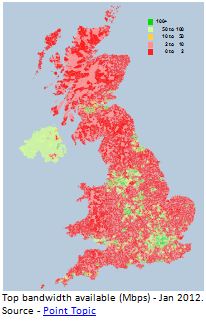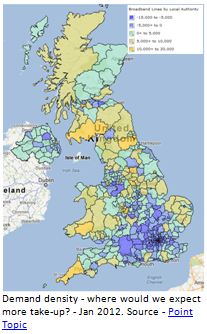Nearly 4 million UK premises still get less than 2Mbps broadband
Data published today by leading broadband research firm Point Topic shows that 13% of UK premises still can’t get broadband speeds higher than 2Mbps. As the UK continues to gain internet bandwidth and consumers, stubborn holes in the deployment and take-up around the country remain.
Point Topic has also completed a comparative study looking at the number of broadband lines it expects to see within an area – given the availability of broadband and demographics in the area – with the actual number of lines.
 “The results show a notable sway towards the South of England, where users have a much higher propensity to take-up broadband than the rest of the UK,” says Oliver Johnson, CEO of Point Topic. “A lot is made of the urban rural digital divide, but the impact of lower broadband take-up in the North would only be expected to add to the general divide in things like health conditions and earnings between the North and South of England.”
“The results show a notable sway towards the South of England, where users have a much higher propensity to take-up broadband than the rest of the UK,” says Oliver Johnson, CEO of Point Topic. “A lot is made of the urban rural digital divide, but the impact of lower broadband take-up in the North would only be expected to add to the general divide in things like health conditions and earnings between the North and South of England.”
Broadband is important – it’s not just about streaming music, movies and Twitter. Businesses are better able to compete, on average revenue goes up and employment increases. Residential customers get access to more educational resources, saving on a variety of services and a better way of finding the next job. Government benefits from it all with a bigger tax base and a better served population.
So where are people getting left behind? Unsurprisingly, towns and cities are usually the first places to get new telecoms services. Suppliers take advantage of the availability of customers and those customers are often prosperous with suitable levels of disposable income.
But even in major cities such as London, there are still areas that get left behind. Residents in the Isle of Dogs suffer with bandwidths often less than 1Mbps. Whilst the bandwidth has been addressed for the corporate customers in Canary Wharf, who are served by a dedicated telephone exchange, the residents had not previously made it onto anyone’s list for better broadband.
“There is light at the end of the tunnel though,” says Johnson. An ‘alternative network’ provider, Hyperoptic, is installing fibre and passing hundreds of residences in this central London blackspot. There are a number of similar bright spots, with some very active local authorities and a number of spectacularly committed smaller organisations doing what they can to face the challenges in place.
Hampshire County Council, for example, has a relatively long running set of projects (http://www3.hants.gov.uk/broadband.htm) aimed at addressing the issues of availability and take-up. “Sharing information, driving interest and stimulating demand are core to the success of any implementation programme in many councils and Hampshire provides a good example of what can be done,” says Johnson.

Community initiatives, like the Broadband 4 Rural North (B4RN) project, also have an important role to play – attacking the commercial deployment models used by operators which heighten the digital divide between rural and urban Britain.
However Johnson does not believe these best efforts will be enough for the UK to achieve its stated goal of 2Mbps for all and ‘the best broadband in Europe’ in the next few years.
“There are still going to be coverage gaps if you analyse the plans to date,” says Johnson. “There are currently 3.7 million premises – residential and business – outside the 2Mbps fixed footprint and we are projecting more than two and a half million still outside the reach of superfast broadband in 2016. It’s the same old story, where commercial deployment isn’t a possibility there are problems getting the promised coverage to the consumer.”
Coverage doesn’t equal access however. Take-up has slowed down. Not only does broadband have to be available, it has to be affordable. The UK ranks in the middle of its European partners when it comes to the relative cost of broadband (when taken as a percentage of average income) and subscription costs, particularly when combined with the cost of an access device, a tablet, computer or the like, is the biggest barrier to take-up.





